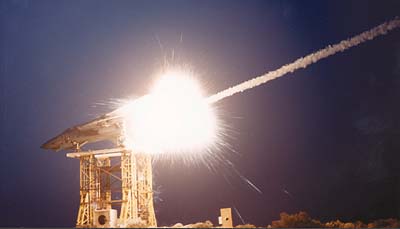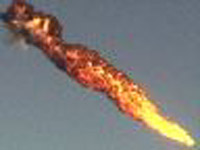|
1999 MANPADS IMPACT TESTS According to a news release by the Public Affairs Department of the Naval Air Warfare Center Weapons Division, the two photographs below help document "the first time the Survivability Division has fired a missile in support of (an) aircraft survivability test." The news release and two photographs comprised an article titled "JLF Test Provides Training and Data for Vulnerability Studies", and appeared in the publication The Weaponeer on July 22, 1999. (http:www.nawcwpns.navy.mil/~pao/jlftest.html) "JLF" stands for "Joint Live Fire": the test jointly involved participants and observers from the Navy, Marine Corps, Air Force, The Federal Bureau of Investigation's crime lab, and the Kern Economic Development Center. The aircraft in question was a Navy F-14 "Tomcat", held in a static pose atop a 27-foot tower. A "Stinger'" air defense missile was launched at the F-14 by Marine Corps Third Low Altitude Air Defense Battalion members from Camp Pendleton from "almost a mile away". Special precautions for this test had to be taken because the target aircraft was to be located so close to ground level: a 5:30 AM test time was selected to help eliminate the influence of surrounding rocks and sand as heat sources that could have made targeting difficult, and "an array of heating elements was used (in the F-14) as a heat source to attract the infrared seeker of the Stinger missile." The F-14 carried no fuel or armaments for this test. According to Leo Budd, the System Vulnerability Branch's project engineer for this test, the purpose of the activity was to "obtain aircraft vulnerability data from highly realistic live-fire testing to support analysis and modeling. A secondary objective was "to pave the way for additional tests needed to gather a more complete understanding of the level, type and extent of damage which the Manportable Air Defense System (MANPADS) produce in combat aircraft and transports." Mr. Budd is quoted in the article as stating "Up to now, there has been little meaningful data on MANPADS impact damage to aircraft". Hence these unprecedented Joint Live Fire tests, just a few months shy of the millennium. A reader of the article may wonder why a good-looking, complete F-14 was required for the test. Why couldn't a large sheet of aluminum or a sheet of heavy plywood or a concrete blockhouse served as a target for the Stinger and the measured effects of such impacts then be extrapolated to the known tolerances of F-14 materials and structures? Why couldn't the forces involved in a non-realistic target impact be carefully measured and then converted to an easy-to-understand computer animation for further study? According to the article, "a complete aircraft was required for the test, since the goal of the Joint Live Fire Program is to study the direct effects of the missile on the F-14's systems and structure." That appears to be a valid concern. Perhaps it should be done more often with a variety of aircraft targets. A reader might then object to the exposure of whole aircraft to missile intercepts. Why not utilize just portions of aircraft rather than potentially trashing an entire aircraft when only a small portion of it would be impacted by a missile? The article counsels that, according to The Institute for Defense Analyses, "the initial test thrust should concentrate on dynamic missile firings into static aircraft as the best value for the effort expended." (emphasis by TWA 800 Casefiles) Proceeding with entire airframes, say these experts, represents the principal of best value, which translates as most the responsible research approach. In other words, if you are going to go to the considerable trouble of firing real missiles, you might as well use a real target instead of a circle on a sheet of paper or a pie tin heated by a blowtorch, and suspended by a coathanger at arm's length by a test agency trainee, or a part of a dismembered aircraft. The first of the photographs accompanying the article in The Weaponeer appears just below. It was taken just before the Stinger hit the F-14.
A devil's advocate, member in good standing and Deacon in the Church of Missile Agnosticism, might conclude it is difficult to determine what that streak of light might be: almost anything between simple camera lens glare and possible missile exhaust is a potential source for that streak. Possibly, says the agnostic, the streak of light shown in the photo was a warning flare shot by test area personnel just before the test...or a meteorite...or fireworks.. If the photograph is an accurate representation of what the JLF test observers saw, then probably no one saw a missile actually hit the F-14, says the agnostic: but many saw a streak of light. And the agnostic believes even streaks like this one do not necessarily and definitively equal missiles. The thing that makes the speculation in the spaces above moot, however, is the reliable sourcing of the photograph as a product of the Naval Air Warfare Center Weapons Division, and of that organization's contention that the photograph shows a Stinger missile just prior to impact. The photograph alone might not convincingly prove a missile would hit the F-14 in the next second. But the sourcing of the photograph persuades the viewer of its bona fides. On the other hand, an eyewitness offhand verbal description of the very same streak in the sky might well be ignored, misinterpreted, or ridiculed. It isn't so much a matter of the image itself, but of subjective influences imparted upon impressions of the image from without. It depends on who and what are telling you what you are looking at...what you have seen...and why...and what you were predisposed to "see" long before the streak appeared. The challenge for the evaluator of the eyewitness information would be to retain a fact-finding focus on what the eyewitness could report, in as much detail as possible, in comparison and contrast to what the body of additional eyewitnesses reported to have seen rather than shifting focus to conclusions imposed upon the eyewitnesses from non-fact-gathering-motivated persons and organizations. No problem with these potentially dangerous dynamics in the JLF test,
but one continues to wonder at the odd treatment of eyewitness information
in the case of TWA Flight 800.
The second photograph is thought-provoking, also. Did officials state that, in the scenario of a MANPADS weapon intercepting TWA Flight 800, there would have been no visible smoke trail? The photo clearly shows a smoke trail from the weapon. "The missile left a smoke trail as it traveled in a low arc and hit its intended target with a loud boom and a flash of light ", the parent article in The Weaponeer states, leaving no doubt but that photographer and naked-eye observers both clearly saw a smoke trail intersect the F-14 target from a launch point of about a mile away. The photograph suggests that Stingers do leave a conspicuous smoke trail in their wake for a minimum of one mile in length, with an unknown maximum length of smoke trail. Also, it appears as if the Stinger involved was a hit-to-kill weapon, creating an ordnance blast about half the size of the F-14 with its small warhead. Since the article stated no fuel or weapons were aboard the F-14, the entire impact flash was a function of the Stinger. It appears the color of the Stinger's detonation couldn't be easily confused with an orange or yellow explosion usually attributed to fuel explosions: it looks brilliantly and radiantly bright-white. (for a reference photograph of a target drone's fuel exploding into a yellow/orange/red plume after a missile impact, examine the graphic below the first horizontal line at the bottom of this page) These three artifacts : the Joint Live Fire test article and its two photographs, shed some light on what a Stinger intercept might look like under certain conditions. They also indicate there is currently significant military and civilian law-enforcement interest in ongoing MANPADS impact exercises and subsequent damage interpretation.They indicate that the nation's experts were aware they possessed little meaningful data available on the topic of MANPADS impact damage to aircraft prior to 1999. They indicate these same experts considered tests on simulated aircraft or portions of an aircraft to be not acceptable if "best value for effort expended" is desired in this important subject area. Certainly when lives are at stake, the American people would demand "best value for effort expended" in this and similar studies.It would not be responsible for any agency of the People to propose to do less. It may be somewhat surprising that the initiatives described here were, according to the Joint Live Fire test article, just beginning in 1999. Considering the nature of the contemporary world, a critic might complain about the appearance of a very late start to the tests. Perhaps the good news is that these critical activities have begun, and are already generating data that might well prove to have a variety of positive applications in military and civil aviation.
Reference photograph not pertaining to JLF test discussed above....presented here as an example of a fuel explosion fireball as opposd to the brilliant white Stinger warhead explosion photgraphed in the JLF test.
"Sidewinder Target Fireball" source: Naval Air Warfare Center Weapons Division / Pacific Ranges and Facilities (http://www.nawcwd.mil/~pacrange/pLib/Land.htm) --- newsletter and individual articles copyright 2000 / T. Shoemaker ---
|


